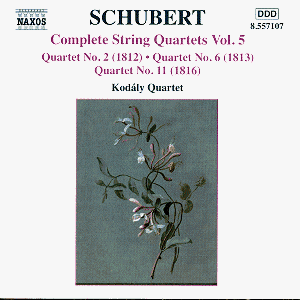The Naxos house quartet’s traversal of the Schubertian
canon continues with this delightful selection of three earlier
works. The musical language adopted is that of eloquent simplicity
and of superb craftsmanship, coupled with the sometimes surfacing
spark of genius. The title to this review reflects the playing
order, the later No. 11 being framed symmetrically by two previous
offerings.
Naxos is lucky to have secured the services of
the Kodály Quartet. Hungarian musical training is legendary
for its emphasis on aural awareness and the unlocking of innate
musicality. The quartet’s members all hail from the Budapest Ferenc
Liszt Academy, and it shows. They bring a sense at times of unbridled
joy to their performances. There is life and the joy of discovery
of early-Schubertian treasures aplenty here.
The calm with which the Kodály Quartet
launches into the D major, D74 belies the ensuing sense of drama.
The first movement is a very imaginative entity, generally sunny
in its echt-Schubertian way. The tension between said drama
and sun provides the impetus for its argument, an underlying breath
of contentment underpinning the sometimes ruffled surface. The
flowing tempo chosen for the Andante is most apposite. Things
really seem to fall into place here, as the Kodály Quartet
shows its liking for lace-like delicacy. The final two movements
provide a surprise success (how often is the Menuetto the highlight
of a reading?) and a disappointment, respectively. The Menuetto
is nice and lusty, given with a most affecting faux-naïveté
(the Trio, with its horn-like accompaniments, is likewise marvellous).
The finale just falls short because it requires that bit more
joy – drama could be invoked more in its later stages, also. All
this leads to a middle-of-the-road, underplayed account that lets
down the excellence established previously.
The E major, D353, has a first movement marked
‘Allegro con fuoco’, although it certainly does not sound very
fuoco here. This is very well-behaved Schubert (hyper-well-behaved,
possibly), the instrumental interchanges being of the politest
fashion. The ‘sigh’ which closes the exposition contrasts well
with the repetition of the opening, but this moment seems to be
marred by a clumsy edit. Nothing spoils the Andante, however.
This is superbly crafted music. Perhaps my one criticism is that
the violin decorations that start around 1’17, could sound less
strained. Still, the repose of this movement sets off the spiky
bite of the Menuetto (itself contrasting with a delightful Trio).
Again it is the finale that is found wanting. There are a few
identifiably awkward corners, but technical concerns apart the
whole movement could be filled with more daylight; could be more
‘open’. While the Kodály’s determined step fits some passages
well, it can seem overbearing.
Finally, to the slighter C major, D32. The first
movement begins in a robust fashion, but it sounds anything but
the prescribed ‘Presto’. Nevertheless, the quartet makes it sound
fresh as a daisy (an extra touch of pace would have added a certain
cheekiness, though!). The Andante is another highlight of this
disc (listen to the sweet first violin theme over a subtly rocking
accompaniment with which it opens). The finale is characterised
by unanimity of attack and a sense of exploration that is quite
simply infectious. In some ways this is the most successful piece
on the disc, as no single movement disappoints.
Some (maybe all) previous volumes of this Schubert
cycle were recorded in a church in Budapest. Here, a more clinical
studio is the venue, and it does the quartet few favours. The
recording is on the harsh side and a little dry: un-Schubertian
qualities, for sure, but the Kodály’s musicality shines
through nevertheless.
Colin Clarke
see also review
by Paul Shoemaker
